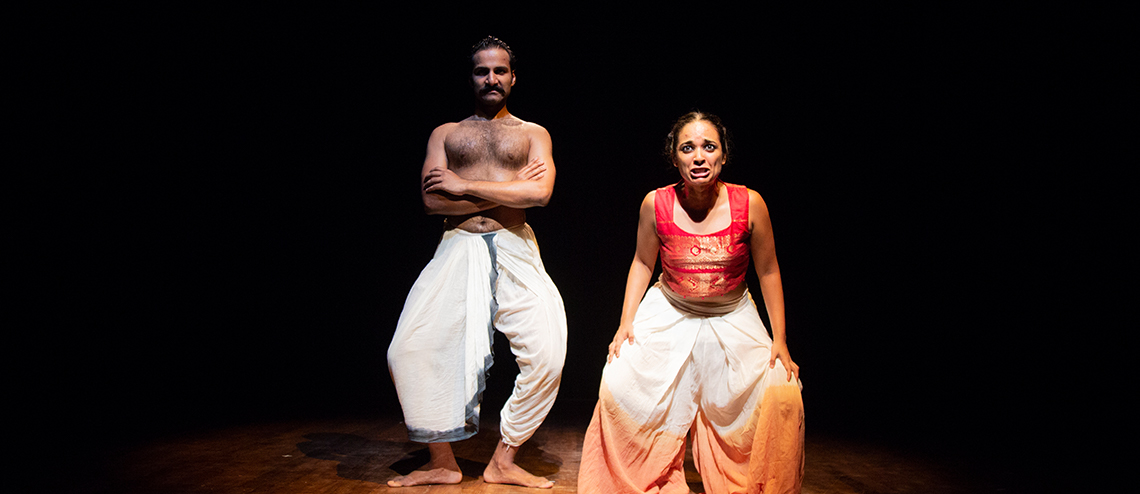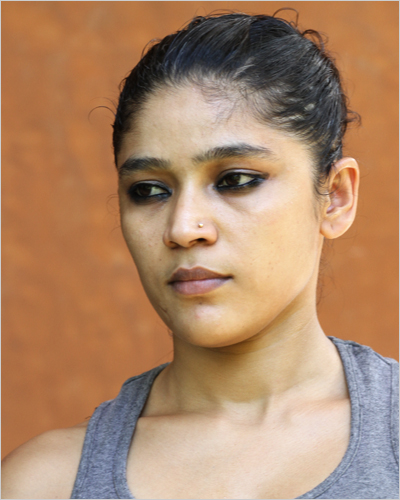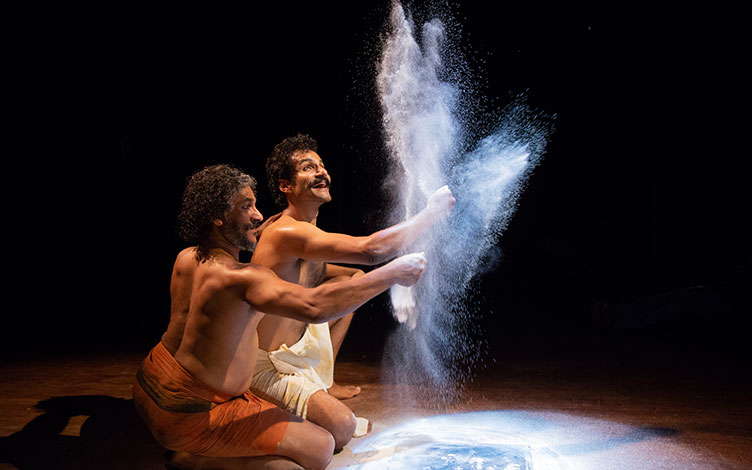It would not be hyperbole to assert that the epics Ramayana and Mahabharata have shaped Indian politics, arts and culture and also those of Southeast Asia. The stories have been repeatedly retold and characters reimagined in many ways through various retellings.
Ramayana, Adishakti’s Bali is a retelling of the various events that led up to the battle between Bali, the ruler of Kishkindha and Ram, the King of Ayodhya and eventually, the death of Bali. Here, the writer has tried to explore the notion of right or wrong through various characters, while steering clear of any subjective influences. Through this play, we explore how one evaluates this notion and, how it can change when each and every character is given an opportunity to voice thoughts and opinions.
The play weaves multiple stories through the viewpoints of Bali, Tara, Sugreeva, Angadha, Ram and Ravan and talks about how each of them makes decisions and takes actions based on the ethics that define their lives.
In Kalaa Utsavam, Adishakti Theatres would stage the international premiere of the play Bali. Connected to India caught up Nimmy Raphel, Director of Bali in which she narrates that Ramayana has become an inseparable part of our lives. She studied Mohiniyattam and Kuchipudi dance in Kerala Kalamandalam from 1995-2001 which she has performed all over India. She is a renowned actor, dancer, and musician at Adishakti, its methodology of theatre since 2001.
CtoI: Bali is an unconventional theme? What made you choose this topic?
Nimmy Raphel: I have been working with Adishakti for the past 17 years. Adishakti as a performance company has been engaged in the research and reanimation of traditional knowledge in theatre, dance, music, movement and craft – with a view to creating a contemporary hybrid aesthetic and performance language. In this regard, Adishakti is in constant dialogue with ideas which can stimulate new performance language and texts.
Choosing the episode of ‘Death of Bali’ was a conscious decision as I was inspired by the Ramayana Festival which was held at Adishakti a few years ago. The play explores the different narratives of a few characters—both well-known and lesser known—from their point of view and the reason behind their actions and decisions, which culminates into the death of Bali. Thus, the play weaves multiple stories—from the point of view of Sugriva to Angadha—to ask some relevant questions about how each of us makes decisions and actions based on the ethics that define our life. As always, through this play, Adishakti’s concern is not to be preoccupied only with issues of the contemporary world, but also with larger ideas, which resonate from the past and could have relevance in the future.
CtoI: The Ramayana and Mahabharata epics have shaped India’s politics, art and culture. How is the topic of Bali relevant in today’s world?
Nimmy Raphel: In India, we have grown up hearing stories. And when it comes to the Ramayana, it feels like we have always known this story. There is nothing like you hearing the Ramayana for the first time. In my life, I have seen Ramayana as a painting on a wall, a story that’s been narrated through the hand gestures of a dancer, in the mesmerising movements of a traditional koodiyattam performer, or as words which occupy the pages of a writer or on a T-shirt that’s hung on the streets.
At one level, I feel you cannot escape this universal story because it has everything that one deals within one’s lifetime – personal struggle, political power struggle, economic power struggle and the notions of justice which connects all these.
In Bali, my primary exploration was to find how one could find different interpretations of the notion of right or wrong? How will I (as the writer of this play) or each one of us in our everyday life answer the question “what ought to be” while making our decisions and actions? Could this essential knowledge said to arise within a community be explored by my characters within this play? While thinking about how sometimes some of the weaker or less prominent ideologies are in danger of being wiped out by dominant ones, I liked the idea of retelling stories from Indian epics to challenge the notion of who or what is right or wrong. Could it be possible to take a step back and detach ourselves from our dominant ideologies and positions to understand the truth behind various other perspectives? These are some questions I want to try and explore through this play.
CtoI: What has been the experience in narrating Bali through the Indian wrestling Kushti?
Nimmy Raphel: We explored the art of Mallayudha, the traditional South Asian form of combat wrestling. This type of wrestling, also called Kushti, forms the main movement language in Bali. In fact, the kushti match between King Bali and King Ravana is said to be the first written attestation for the word Mallayudha in Ramayan. Within this form, we would like to focus primarily on Hanumanti, which concentrates on technical movements and Jambuvanti, which uses holds and locks to pin the opponent down.
We believe that a deeper understanding of this form would give valuable insights and perhaps, new aesthetics to the central idea on which Bali is based. Secondly, kushti, which is considered one of the most respected sports in India is also about understanding how wrestlers view their bodies and the art itself as a public performance. As performers, we are trying to stretch the culturally accepted boundaries by exploring kushti as a unique form of body discipline and a stage for self–presentation to derive a language for theatre.
Kushti gives the audience all grandiose and the scale where the fighters have to skillfully employ the techniques appropriate to the challenges and uncertain scenarios in a tournament. This means the wrestlers will have to be psychologically prepared in addition to the physical strength that will be demanded of them. Our interactions with a professional wrestler have left us with more scope to understand how actors perceive the same. This aspect becomes the important part of this play as this tale of rivalry and treachery is as unpredictable as a wrestling match because the characters themselves are in a state of constant psychological tension. Thus Kushti already provides us with a set framework to explore these movements and emotions.
CtoI: What is the relevance of Esplanade’s Kalaa Utsavam – Indian Festival of Arts for you?
Nimmy Raphel: We have heard of Kalaa Utsavam – Indian Festival of Arts from friends who have been part of the festival before and we have wanted to be part of this festival for a long time. In our earlier visit to Singapore, it was very noticeable that the space is a melting pot of energy. In this context to perform at such a festival gives Adishakti an opportunity to share the work with a wider audience.
CtoI: How do you think Kalaa Utsavam plays an important role in bringing people closer to Indian music and culture?
Nimmy Raphel: As far as Adishakti is concerned any festival which includes a wide variety of content in its festival list brings in a great opportunity for artists to meet, to have a dialogue and also to share the creative journey which each individual artist might be engaged in. Looking at Kalaa Utsavam and its lineup of performances, we are sure Kalaa Utsavam has achieved this and much more.



